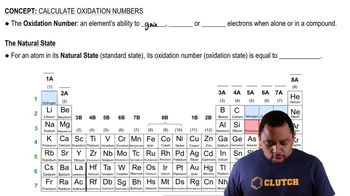Magnesium, the element, is produced commercially by electrolysis from a molten salt (the 'electrolyte') using a cell similar to the one shown here. (c) Recall that in an electrolytic cell the anode is given the + sign and the cathode is given the – sign, which is the opposite of what we see in batteries. What half-reaction occurs at the anode in this electrolytic cell?
Indicate whether each of the following statements is true or false: (a) If something is oxidized, it is formally losing electrons.
 Verified step by step guidance
Verified step by step guidance
Verified video answer for a similar problem:
Key Concepts
Oxidation and Reduction

Oxidation States

Electron Transfer

(b) On which side of an oxidation half-reaction do the electrons appear?
Indicate whether each of the following statements is true or false: (c) If there are no changes in the oxidation state of the reactants or products of a particular reaction, that reaction is not a redox reaction.
Indicate whether each of the following statements is true or false: (c) An oxidizing agent is needed to convert CO into CO2.
For each of the following balanced oxidation–reduction reactions, (i) identify the oxidation numbers for all the elements in the reactants and products and (ii) state the total number of electrons transferred in each reaction. (a) I2O5(s) + 5 CO(g) → I2(s) + 5 CO2(g) (b) 2 Hg2+(aq) + N2H4(aq) → 2 Hg(l) + N2(g) + 4 H+(aq) (c) 3 H2S(aq) + 2 H+(aq) + 2 NO3-(aq) → 3 S(s) + 2 NO(g) + 4 H2O(l)
